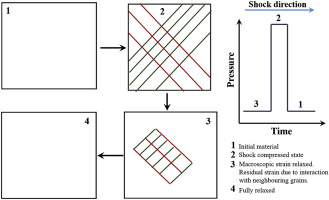当前位置:
X-MOL 学术
›
Acta Mater.
›
论文详情
Our official English website, www.x-mol.net, welcomes your feedback! (Note: you will need to create a separate account there.)
Observation of ex-situ microstructure relaxation of non-conventional misorientations post femtosecond laser shock exposure in cp-Ti
Acta Materialia ( IF 9.4 ) Pub Date : 2018-05-01 , DOI: 10.1016/j.actamat.2018.03.001 Anuj Bisht , Rajib Kalsar , Amitava Adak , Indranuj Dey , Kamalesh Jana , Amit Lad , G. Ravindra Kumar , Gopalan Jagadeesh , Satyam Suwas
Acta Materialia ( IF 9.4 ) Pub Date : 2018-05-01 , DOI: 10.1016/j.actamat.2018.03.001 Anuj Bisht , Rajib Kalsar , Amitava Adak , Indranuj Dey , Kamalesh Jana , Amit Lad , G. Ravindra Kumar , Gopalan Jagadeesh , Satyam Suwas

|
Abstract The effect of shock passage in commercially pure titanium (cp-Ti) with minimal macroscopic plastic strain was investigated in the present study. For the first time, ex-situ residual strain relaxation in a shocked material was recorded post-shock exposure. Femtosecond laser was used to produce a shock in cp-Ti. Post-shock investigation was carried using EBSD, TEM imaging, and TEM OIM. Uniform but low misorientations were observed inside the grains. Lamella like structures and nano grain pockets were present in the material. Observed misorientations of the remnant nanograins correspond to the multiple twinned region of twins with low twinning shear. However, a large fraction of misorientation pertains to the double twinned structure. Lattice misorientation build-up was absent in the microstructure, in spite of a large number of defects observed. This is confirmed by the GND component analysis, indicating that the macroscopic plastic strain is minimal. The lattice displays alternating curvature which cancels out over long distances, which indicates the presence of SSDs. Ex-situ strain relaxation was observed in the TEM sample resulting in bending of the TEM lamella about the triple point junction of grain. This resulted in the reverting back of defects to the parent grain, which is similar to defect annihilation on shock unloading as reported in previous MD simulations. A schematic spanning the microstructural changes before and after shock passage, and showing the effect of further strain relaxation on the microstructure is shown.
中文翻译:

在 cp-Ti 中观察飞秒激光冲击暴露后非常规错误取向的非原位微结构弛豫
摘要 本研究研究了具有最小宏观塑性应变的商业纯钛 (cp-Ti) 中冲击通道的影响。首次在冲击暴露后记录了冲击材料中的异位残余应变松弛。飞秒激光用于在 cp-Ti 中产生冲击。使用 EBSD、TEM 成像和 TEM OIM 进行了冲击后调查。在晶粒内部观察到均匀但低的取向差。材料中存在片状结构和纳米颗粒袋。观察到的残余纳米晶粒的错误取向对应于具有低孪晶剪切的孪晶的多重孪晶区域。然而,很大一部分取向错误与双孪晶结构有关。微观结构中不存在晶格取向错误,尽管观察到大量缺陷。GND 分量分析证实了这一点,表明宏观塑性应变最小。晶格显示交替曲率,在长距离内相互抵消,这表明 SSD 的存在。在 TEM 样品中观察到非原位应变松弛,导致 TEM 薄片围绕晶粒的三相点结弯曲。这导致缺陷返回到母体晶粒,这类似于先前 MD 模拟中报告的冲击卸载时的缺陷湮灭。示意图涵盖了冲击通过前后的微观结构变化,并显示了进一步应变松弛对微观结构的影响。晶格显示交替曲率,在长距离内相互抵消,这表明 SSD 的存在。在 TEM 样品中观察到非原位应变松弛,导致 TEM 薄片围绕晶粒的三相点结弯曲。这导致缺陷返回到母体晶粒,这类似于先前 MD 模拟中报告的冲击卸载时的缺陷湮灭。示意图涵盖了冲击通过前后的微观结构变化,并显示了进一步应变松弛对微观结构的影响。晶格显示交替曲率,在长距离内相互抵消,这表明 SSD 的存在。在 TEM 样品中观察到非原位应变松弛,导致 TEM 薄片围绕晶粒的三相点结弯曲。这导致缺陷返回到母体晶粒,这类似于先前 MD 模拟中报告的冲击卸载时的缺陷湮灭。示意图涵盖了冲击通过前后的微观结构变化,并显示了进一步应变松弛对微观结构的影响。这导致缺陷返回到母体晶粒,这类似于先前 MD 模拟中报告的冲击卸载时的缺陷湮灭。示意图涵盖了冲击通过前后的微观结构变化,并显示了进一步应变松弛对微观结构的影响。这导致缺陷返回到母体晶粒,这类似于先前 MD 模拟中报告的冲击卸载时的缺陷湮灭。示意图涵盖了冲击通过前后的微观结构变化,并显示了进一步应变松弛对微观结构的影响。
更新日期:2018-05-01
中文翻译:

在 cp-Ti 中观察飞秒激光冲击暴露后非常规错误取向的非原位微结构弛豫
摘要 本研究研究了具有最小宏观塑性应变的商业纯钛 (cp-Ti) 中冲击通道的影响。首次在冲击暴露后记录了冲击材料中的异位残余应变松弛。飞秒激光用于在 cp-Ti 中产生冲击。使用 EBSD、TEM 成像和 TEM OIM 进行了冲击后调查。在晶粒内部观察到均匀但低的取向差。材料中存在片状结构和纳米颗粒袋。观察到的残余纳米晶粒的错误取向对应于具有低孪晶剪切的孪晶的多重孪晶区域。然而,很大一部分取向错误与双孪晶结构有关。微观结构中不存在晶格取向错误,尽管观察到大量缺陷。GND 分量分析证实了这一点,表明宏观塑性应变最小。晶格显示交替曲率,在长距离内相互抵消,这表明 SSD 的存在。在 TEM 样品中观察到非原位应变松弛,导致 TEM 薄片围绕晶粒的三相点结弯曲。这导致缺陷返回到母体晶粒,这类似于先前 MD 模拟中报告的冲击卸载时的缺陷湮灭。示意图涵盖了冲击通过前后的微观结构变化,并显示了进一步应变松弛对微观结构的影响。晶格显示交替曲率,在长距离内相互抵消,这表明 SSD 的存在。在 TEM 样品中观察到非原位应变松弛,导致 TEM 薄片围绕晶粒的三相点结弯曲。这导致缺陷返回到母体晶粒,这类似于先前 MD 模拟中报告的冲击卸载时的缺陷湮灭。示意图涵盖了冲击通过前后的微观结构变化,并显示了进一步应变松弛对微观结构的影响。晶格显示交替曲率,在长距离内相互抵消,这表明 SSD 的存在。在 TEM 样品中观察到非原位应变松弛,导致 TEM 薄片围绕晶粒的三相点结弯曲。这导致缺陷返回到母体晶粒,这类似于先前 MD 模拟中报告的冲击卸载时的缺陷湮灭。示意图涵盖了冲击通过前后的微观结构变化,并显示了进一步应变松弛对微观结构的影响。这导致缺陷返回到母体晶粒,这类似于先前 MD 模拟中报告的冲击卸载时的缺陷湮灭。示意图涵盖了冲击通过前后的微观结构变化,并显示了进一步应变松弛对微观结构的影响。这导致缺陷返回到母体晶粒,这类似于先前 MD 模拟中报告的冲击卸载时的缺陷湮灭。示意图涵盖了冲击通过前后的微观结构变化,并显示了进一步应变松弛对微观结构的影响。


























 京公网安备 11010802027423号
京公网安备 11010802027423号